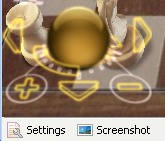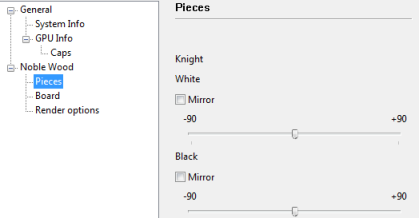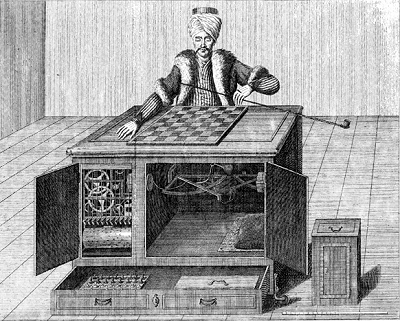|
3D board – Settings |

|

|
|
|
3D board – Settings |

|

|
3D board – Settings
3D Settings (bottom left of the 3D board window)

This produces a dialog in which you can select one of many 3D designs and then optimize it for your screen and graphics card.

Here is a short description of what some of the main categories are. Note that you may find additional boards in your Settings dialog, especially after major updates.
![]() Fritz Room – this is a classical Spanish chess room, with a table, chairs, pictures, bookshelves, etc. You can use the 3D control functions to explore the room, or zoom into the board and analog clock to play a game of chess.
Fritz Room – this is a classical Spanish chess room, with a table, chairs, pictures, bookshelves, etc. You can use the 3D control functions to explore the room, or zoom into the board and analog clock to play a game of chess.
![]() Glass, wood, marble, metal, modern, silver, simple, classic, Prague – these are chessboard and piece sets in various materials, designs and styles. Some are in very high detail and can take your graphics card to its limits. But you can also generate spectacular chessboard pictures using the "Screenshot" function at the bottom of the window.
Glass, wood, marble, metal, modern, silver, simple, classic, Prague – these are chessboard and piece sets in various materials, designs and styles. Some are in very high detail and can take your graphics card to its limits. But you can also generate spectacular chessboard pictures using the "Screenshot" function at the bottom of the window.
![]() Symbol boards have very flat symbol pieces that are used with the board in an upright position, much like the graphic 2D board, except that the symbols have clear 3D forms.
Symbol boards have very flat symbol pieces that are used with the board in an upright position, much like the graphic 2D board, except that the symbols have clear 3D forms.
![]() Egypt, Shredder, etc. are boards with imaginatively sculptured pieces, for instance ancient Egyptian figures perched on the top of a pyramid.
Egypt, Shredder, etc. are boards with imaginatively sculptured pieces, for instance ancient Egyptian figures perched on the top of a pyramid.
![]() Mia, Turk – these are new and very ambitious simulations of a futuristic Metropolis-like robot or the famous Chess Turk built in the 18th century by the Hungarian engineer Baron Wolfgang von Kempelen.
Mia, Turk – these are new and very ambitious simulations of a futuristic Metropolis-like robot or the famous Chess Turk built in the 18th century by the Hungarian engineer Baron Wolfgang von Kempelen.
The Turk was a very famous chess-playing automaton, which was constructed in 1769 by Wolfgang von Kempelen (1734-1804) to entertain the Austrian Empress Maria Theresa. It was built in the form of a maplewood cabinet, 4 feet long by 2 feet deep and 3 feet high, with a figure dressed in a cloak and turban seated behind it. The cabinet doors could be opened to reveal internal clockwork mechanisms, and appeared to have no place in which to conceal a human player. But still the machine was able to play a strong game of chess against any opponents (even Napoleon tried his hand against it).

Contemporary copper engraving of von Kempelen's Turk
The point of the illusion was that a chess player was actually able to conceal himself very cleverly during the inspection of the machine, and then operate the Turk with the help of levers during the game.